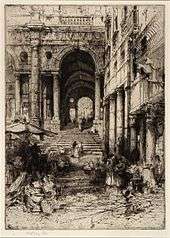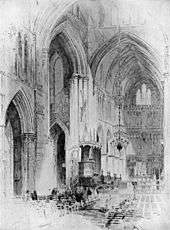Hedley Fitton
Hedley Fitton (c. 1858 – 19 July 1929) was an England engraver and printmaker noted mainly for his architectural etchings. His etchings included street scenes and important cathedrals in London, Florence, Edinburgh, and Paris. In 1907 the Société des Artistes Français awarded Fitton a Gold Medal for his work.

Fitton was born in Didsbury, Manchester, and was a pupil at the Warrington School of Art in Cheshire. He travelled and worked extensively in England, Scotland, France and Italy. He lived in Didsbury in the 1890s, working as editor and illustrator for The Daily Chronicle in Manchester, and around 1898 at Shottermill in Surrey - the rest of his life was spent at Haslemere in Surrey.
His work was exhibited at the Royal Academy, Royal Society of Painter-Etchers and Engravers, Royal Watercolour Association and at the Paris Salon.[1]
Hedley Fitton was familiar with the old windmills on the southeast coast not far from London and produced a popular etching called "The Two Mills". His best known works are "The Pantheon, Rome" and "The Rose Window, Notre Dame". His etchings depict many of the venerated landmarks of the time.[2]
External links
Bibliography
- Dunthorne, Robert - Illustrated Catalogue of Etchings by Hedley Fitton, R.E. with Descriptions. (London, 1911)
- Fuller, Errol - Hedley Fitton: The Accent of Truth. (Tunbridge Wells, Kent, UK, 2010). ISBN 978-0-9533553-2-7
- Banks, Mrs. Linnaeus - The Manchester Man - Illustrated by Charles Green and Hedley Fitton - Manchester, Abel Heywood & Son (1896)
References
- "Heatons biography". Archived from the original on 2008-07-03. Retrieved 2008-07-03.
- Romulata
| Wikimedia Commons has media related to Hedley Fitton. |
